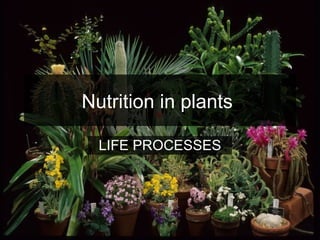Nutrition in plants
- 1. Nutrition in plants LIFE PROCESSES
- 2. Learning Objectives 1) What are life processes? 2) What is nutrition? 3) Types of nutrition 4) Plant nutrition 5) Why is photosynthesis important? 6) Photosynthesis 7) Steps of photosynthesis 8) What are the conditions necessary for photosynthesis? 9) How do CO2 & H2O enter the plants? 10)The fate work of guard cells 11)Other needs of plants
- 3. What are life processes? Various functions carried out by living beings; which are necessary to maintain and continue life are called life process. âĒNutrition âĒRespiration âĒTransportation âĒExcretion âĒMovement âĒReproduction
- 4. What is nutrition? âĒ The process by which an organism takes food and utilizes it is called nutrition. âĒ Need of nutrition: Organisms need energy to perform various activities. The energy is supplied by the nutrients. Organisms need various raw materials for growth and repair. These raw materials are provided by nutrients.
- 6. PLANT NUTRITION âĒ Green plants prepare their own food. They make food in the presence of sunlight. Sunlight provides energy, carbon dioxide and water are the raw materials and chloroplast is the site where food is made.
- 7. Why is photosynthesis important? âĒ Photosynthesis is the main way through which the solar energy is made available for different living beings. âĒ Green plants are the main producers of food in the ecosystem. All other organisms directly or indirectly depend on green plants for food. âĒ The process of photosynthesis also helps in maintaining the balance of carbon dioxide and oxygen in the air. Why photosynthesis?
- 8. Photosynthesis âĒ Photosynthesis is the process by which light energy absorbed by chlorophyll is transformed into chemical energy used to make carbohydrates from water & carbon dioxide. Oxygen is released during the process. What is photosynthesis?
- 9. Steps of Photosynthesis âĒ Sunlight activates chlorophyll; which leads to splitting of water molecule. âĒ The hydrogen; released by splitting of water molecule is utilized for reduction of carbon dioxide to produce carbohydrates. âĒ Oxygen is the byproduct of photosynthesis. âĒ Carbohydrate is subsequently converted into starch and is stored in leaves and other storage parts. âĒ The splitting of water molecules is part of the light reaction. âĒ Other steps are part of the dark reaction during photosynthesis.
- 10. Q. What are the conditions necessary for photosynthesis? âĒ Sunlight âĒ Chlorophyll (green pigment) âĒ CO2 âĒ Water âĒ Suitable temperature Photosynthesis conditions Sunlight, Chlorophyll & CO2 are essential for photosynthesis. Other conditions needed are a suitable temperature and water.
- 11. How do CO2 & H2O enter the plants? Pathway of CO2 from atmosphere through Stomata to rest of the plant.
- 12. The fate work of guard cells âĒ Plants 'breathe' and 'sweat' through their stomata, which are regulated by guard cells. Guard cells have a very important job because by opening and closing stomata, they facilitate gas exchange for photosynthesis and help minimize water loss.
- 13. GUARD CELLS
- 14. Other need of the plants âĒ Other materials like nitrogen, phosphorus, iron and magnesium are taken up from the soil. âĒ Nitrogen is an essential element used in the synthesis of proteins and other compounds n is taken up in the form of nitrates or nitrites.















